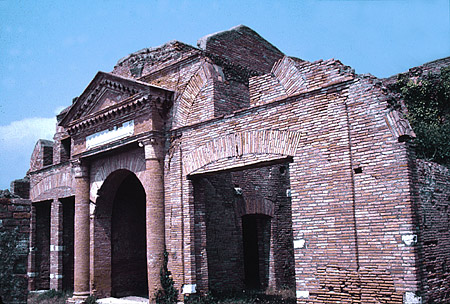
You stand in front of the Horrea Galbana, Rome's largest warehouse, approximately 219 x 170 yards, with 140 individual storerooms on the ground floor alone (Note: the photo you see here depicts a warehouse in Ostia, the Horrea Epagathiana). You look around for the tomb of Servius Sulpicius Galba, a Republican consul in the late second century BCE after whom the warehouse is named. When you try to enter the building, you are stopped by a guard (custodiarius); security is very tight because of the value of the goods stored here. The building is constructed with thick walls and few external windows or entrances, and you see many iron locks and bolts (see a Roman lock and hasp, and a lock with matching key). Although you can't get in, you remember that this warehouse, like most Roman horreae, is constructed of many individual storerooms that open onto several internal courtyards to facilitate access by porters and to circulate air (see this model of the Horrea Galbana and this plan).
Many goods are stored here, but particularly olive oil and wine, the two liquids that keep the city well lubricated. Huge wide-mouth pottery containers lined with pitch or wax, called dolia, were used to store goods; these were often partially buried in the ground to keep them upright and to keep the goods cool. Although olive oil is an important ingredient in Roman cooking, huge quantities are used for other purposes, including providing fuel for the lamps at night and oiling the body at the Baths. Liquids like these are transported in large terracotta jars called amphorae, which have distinctive shapes for various commodities. Oil amphorae tend to be squat and round (see this mosaic of a ship carrying such round amphorae), while wine amphorae are longer and thinner (see this model of a riverboat carrying wine amphorae). When olive oil is stored in clay vessels, the interior absorbs some of the oil, which then turns rancid and smelly, so the Romans do not consider this type of amphora to be reusable. You are reminded of this as you look up to the Mons Testaceus, a large artificial hill composed almost completely of broken fragments of oil amphorae, which is located behind and to the right of the warehouse. In keeping with the Roman passion for organization, however, you note that this is not simply a haphazard dump heap. Instead, the mound is composed of terraced levels with retaining walls (also composed of fragments); the amphorae are taken up whole and broken on the mound, and then their pieces are leveled out and sprinkled with powdered lime to neutralize the smell.
The importation of wine is also a big business, for what self-respecting Roman could live without wine? A wealthy wine merchant left a large stone monument representing a wine cargo ship, and this relief shows a wine shop with satisfied customers and a wagon transporting wine overland. All this thinking about wine has made you thirsty, and you decide to head over to the Thermopolium of Scintilla to have a drink yourself!